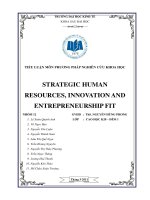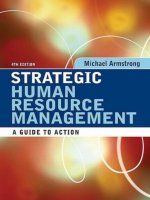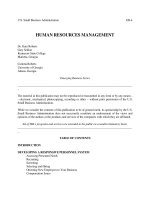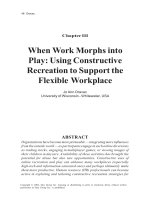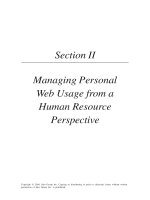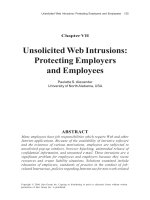Strategic human resources management cas
Bạn đang xem bản rút gọn của tài liệu. Xem và tải ngay bản đầy đủ của tài liệu tại đây (797.29 KB, 14 trang )
Tarmac
Strategic Human Resources Management: A Case Study
Samantha Rae Tan
CIB0000380
Introduction
When one hears the name Tarmac, most probably the first thought that pops into mind
would be a construction scene with concrete, bulldozers, cement, heavy machinery and of
course, people in orange vests wearing yellow hardhats. These people could be considered as
the faces of Tarmac, however they are in fact only part of an even bigger and deeper
organization. That being said, all the human resources within Tarmac are managed to work
together on one mission to achieve one goal, which is – “To deliver the highest value for our
customers, communities, employees, and investors”.
This paper is a case study on Lafarge Tarmac – a well-known business of building
materials and aggregates which originated in the UK – employing nearly 11,000 people for
various skilled positions. Through studying the company, this paper will be able to identify the
differences between traditional HRM and SHRM, the functions and different models, and the
benefits of various strategies that could be applied to the company. Besides that, the factors
that could affect its functions in the business environment will be evaluated as well as the
integration ways the company uses to achieve goals. Last but not least, the roles of the HR team
in leading and implementing organisational change will be identified and studied.
All in all, this case study will ensure the clear understanding of different elements in
SHRM through the lens of Tarmac, which would definitely aid aspiring businessmen in leading
its own human resources.
1
Samantha Rae Tan
CIB0000380
Section 1: SHRM
Question 1:
A. Three differences between Traditional Human Resource Management and Strategic
Human Resource Management:
One difference between the two is how the employees are treated. For HRM, the
employees are merely the workforce needed to get the job done in return for financial
payment. However, for SHRM it’s more than that – employees get the job done in return
for not only financial payment, but also with their own personal growth and satisfaction in
mind. SHRM treats their employees as people, not just robots who would do everything
they are told to do. Another difference is regarding the time horizon of their functions –
HRM is only short term and on the other hand SHRM can be short, medium, and most
especially long term. Also, in terms of their aim and key investment, HRM does what it
does for the sake of saving as much money as it can while utilizing its workforce for the
company. For SHRM, it does that as well but it does that while taking care of the workforce.
It gives importance to investing on the people’s skills, knowledge, and personalities to
achieve and maintain competitive advantage.
In relation to that, apparently Tarmac utilizes SHRM in way that it treats its people as
the most important resource who need to be engaged, interested, developed, and motivated.
They recruit specialist employees for specific roles through strategic recruitment
procedures involving the whole business in mind, and thus they have to make sure that the
people possess the right skills and knowledge to meet the objectives.
B. Four roles of SHRM
1. Strategic Partner – As a company which produces aggregate across UK and various
wholesale & private customers in different countries, there is a need for Tarmac to
operate on a proper organisational structure. The HRM is thus responsible for this
in order to formulate the correct structure, to monitor and ensure it is implemented
properly, to find ways to improve and change it again if needed, and also to always
act as partners with the other operation managers – not just people who find people
for the company – but as real partners.
2. Administrative Expert – It is common to think that HR people are mainly
administrators concerned with the workforce in the company, however, HR experts
are actually experts as administrators itself – they can perform their functions in
various effective ways to be better, faster, for cheaper and less time and even be
2
Samantha Rae Tan
CIB0000380
able to participate in the company more as strategic partners. In Tarmac for instance,
it has a detailed process for recruitment in order to gather the right people for the
right positions. To efficiently do so, they can rely on technologies that could filter
automatically the CVs and cover letters, and other documents they receive from
applicants, to save time on shortlisting for interviews. This would be beneficial as
it would speed up the intricate process of choosing numerous diverse skilled people
from a range of a backgrounds.
3. Employee Champion – To the employees, the bosses are people who they follow as
leaders, while the HR department are people they expect they can rely on. For
Tarmac, which focuses on the importance of engaging their employees for them to
remain committed, there is a need for the HR to function as their champions who
help and protect them. They help Tarmac employees be motivated by giving
orientations and training to the line management regarding how and why employees
must have high morale. They also help by being their voice within the management
for their concerns and opinions, and with their voice they participate in the decisionmaking as well – this serves as providing them with excellent communication
systems. Lastly, Tarmac ensures the employees morale by recognizing their
performance and reward them accordingly for their efforts and achievements.
4. Change Agent – Nothing is permanent in businesses, especially when it concerns
people. As ones who have the responsibility over the workforce in the company,
HR people are the ones who must aid the organisation to adapt quickly to any
changes. They are the ones to often initiate, if not facilitate organisational changes
such as in technology and the structure aside from the people. Tarmac faces the
situation in the market place wherein it needs to respond quickly to future
challenges, which is why their human resources look out for internal change where
individuals leave to take other posts, individuals retire, some are promoted, there
are new technologies that have to be taught and trained, and even the economic
climate that may result in more or less demand for the products.
C. Two major HR strategies of Tarmac
Tarmac immensely benefits from developing its own diverse workforce, and with that,
it has become a purpose for the company to handle them with the following two major
strategies:
3
Samantha Rae Tan
CIB0000380
1. Diversity – according to the case study, Tarmac sees diversity as all the complex
ways in which people are different, from gender, ethnicity, religion, political beliefs
and etc. This enables Tarmac to provide its customers with something special and
beyond their normal expectations – this is
because Tarmac shows value to each of
their distinctive qualities, thus guaranteeing
their “feel good factor”. Aside from that, it
promotes family-friendly working patterns
for both genders, as well as bullying will be
less if not none at all, and the same goes for
harassment.
Illustration 1: Source - />sity.png
2. Inclusion – this on the other hand is the act of embracing all the differences, it is
valuing it all and even enabling every member to exploit their strengths. For
example, as a company mainly focused on construction, it has been a stereotype
that the workforce is composed of males, but although at present 86% are males,
Tarmac has sought to change that and women are being employed even more for
different roles and levels – thus it has aimed for the working culture of valuing each
other’s differences to utilize and develop each one’s potentials.
That being said, there are two main points as to how and where these strategies fit in
Tarmac’s organisational value chain. First is that Diversity and Inclusion serves as the strategy
to achieve the company’s competitive advantage – which means it is basically the company’s
work culture, it is the way every department in the company works. Marketing and Sales for
example which is focused mainly on generating revenue and customers must always focus on
diversity and inclusion not only amongst themselves, but on the customers as well. Second is
that the strategies are mainly from the Human Resources Management since the workforce is
the lifeblood of the company – it is the main source of the strategies. It is where the
management focuses on instilling the values upon each employee, monitoring their
performance based on the alignment with the strategies as well as evaluating them. Therefore
diversity and inclusion are both strategies that fit in both primary and support activities as a
whole.
4
Samantha Rae Tan
CIB0000380
Section 2: SHRM Models
Question 2: Two Best SHRM models for Tarmac:
1. Business Partner Model – Tarmac’s core goals (DREAM) are a set of aims that cannot
be achieved so easily without the cooperation of all departments and teams. Thus, HRM
should not just be the traditional human resources who do paperwork, they must
undertake four roles in one as discussed by David Ulrich, and also explained
beforehand. Through these four roles, HRM will participate in decision making along
with other leaders, aligning the HR initiatives with all the core strategies within the
business, (Schwarts, 2011). With that, DREAM will be achieved more efficiently. The
second reason is that Tarmac is driven and focused to embrace change, and this model
is perfect for that since through the model, HR professionals will focus on supporting
and often leading changes within the organisation through being change agents.
Advantages – Through the model, Tarmac HR will have storing relationships with the
executive management, with their leading role in the company being highly visible.
Another is that HR will not be the last to hear any news regarding the company, HR
will be part of that – thus there is fast response time in case there are big corporate
problems.
Disadvantages – However, in being more focused with the strategic business
partnering, the equally important role of HR to interact personally with customers will
be less emphasized. Also, there will be less emphasis on the rewards system for
employees who are doing great.
2. E-HR Model – With over 6,000 employees, it would be a good option for Tarmac to
peruse this model because it will simplify all paperwork that are often so timeconsuming and would require more manpower. This would align Tarmac to the
background of being innovative and modern, wherein all HRM services required from
5
Samantha Rae Tan
CIB0000380
the department will be offered via intranet for all employees’ use, (Rüel, Bondarouk, &
Looise, 2004). Also, with that, the HR will be able to focus more on its core activities
including decision making, employee relations, and etc.
Advantages – Through this model, all employees including the management will have
their own “personal portal” that could definitely improve productivity due to the
tailored information provided by the technology. Also, the web technology is then fool
proof – meaning there will be less errors committed as compared to the normal call
centre model.
Disadvantages – Though it is quite advantageous, it cannot be denied that the downside
to it is that the HR managers’ time will be more difficult to spare due to the fact that
they will be focused on more important things and the technology will already basically
provide for everything else anyway. With that comes the problem wherein certain HR
issues that need human cognition will be difficult to solve, especially if the E-HR is
being heavily relied on. Another disadvantage is that these technologies could need time
and set-up costs, plus even when it has been completed, results may not even be what
was expected. Therefore, it also has risks.
Section 3: Designing and Implementing HR Strategy
Question 3:
A. Tarmac organisational life cycle stage – Currently, it would be easy to identify that
Lafarge Tarmac is on its Maturity stage. With a revenue that has reached more than a
billion and continuously increasing, Lafarge UK and Tarmac both have weighted
presence in the construction industry made even more significant through their merger,
(Hanna, 2014). They have stable organisation culture and have already incorporated
retention strategies for the employees, as well as continuously provides training with
regards to the HR & employee relations. Stuart Wykes, the Director of Land and
Natural Resources who is a leader in the company stated, “Our approach to operational
excellence and our innovative, high quality products will help us maintain our leading
position and create the sustainable communities of the future,” (Hanna, 2014). This
statement shows that they are indeed in the leading position, and thus seek to maintain
that maturity.
Knowing one’s stage in the organisational life cycle is very important because
it would provide the company with the knowledge on the situation and position it
6
Samantha Rae Tan
CIB0000380
currently is in in the market. Whether it is still developing and growing, or if it is already
reaching its highest peak, or if it is already failing and unless major changes will be
done the company will bankrupt. Just knowing the current stage would make the
decision-makers be continuously alert and stay on their toes. The second reason it is
beneficial is that with this alertness, they will be able to find out whatever they need to
do and whatever would affect these decisions they are about to impose. Therefore, it
becomes a thorough research about the company both internally as well as externally.
B. Benefits of Diversity & Inclusion Strategy
a. First and foremost, this combined strategy adheres to one of the world’s current
most important legal requirement for employment – equal opportunities. With
this, Tarmac is not only complying with the requirement, it is promoting it and
showing the world that it is possible and beneficial for companies as successful
as theirs.
b. Next, Tarmac’s diverse workforce reflects their inclusive target market – they
do not focus on niche markets only. They serve various customers, as long as
they are needed they will provide no matter who the customers are. For example,
clients from a less developed country’s government require their services on
building a concrete road for charity schools. Tarmac, with its workforce with
understanding and background on such scenarios will have more inclination to
help.
c. Another is that due to the range of skills and experiences they draw from the
diverse workforce, Tarmac is quite adaptable to changes. If for example one of
the offices suddenly closed due to a terrible earthquake, employees with
experience on surviving natural disasters will not only be able to adjust better
but will also be able to cheer up the colleagues, to influence them and motivate
them to continue working in another office.
d. Last but not the least, the great cultural understanding leads the employees
providing customers and clients with better service. Especially since Tarmac
operates internationally, culture is one of the most important external factors
that should be considered in dealing with people. Through understanding the
Japanese business etiquette for example, on the proper way of giving and
receiving business cards, there will be a give and take of respect for each other.
For the Japanese, a business card is an extension of oneself and thus must be
7
Samantha Rae Tan
CIB0000380
given and received respectfully with both hands. If this is practiced even with
the non-Japanese, Tarmac will all the more be seen as professional and
culturally knowledgeable.
Section 4: Business Environment Factors, Integration of HRM, Leadership
Roles of SHRM
Question 4:
External
Internal
Environmental Factors
Employees
Technological Factors
Customers
Figure 1: External & Internal Business Environment Factors
Tarmac heavily relies on raw materials for the building aggregates and materials, thus
the environment is one of the major factors which could influence the HR strategies. The
weather, natural disasters and man-made degradation of nature can affect everything terribly.
As mentioned before, if for example an earthquake transpired and ruined one of the offices, all
staff and employees will have to be relocated and support should be given due to the
unfortunate situation they have been in in the workplace. With this, HR will have to strategize
carefully along with other departments on the “what ifs” in the future.
Technology is ever changing from operations’ machineries down to the administrative
computers and all else. With this, Tarmac must also be updated and take advantage of the
benefits of technological progress such as upgraded iHRIS systems that could provide for the
easy management of thousands of staff and employees within the company. If however the
company doesn’t, it will slow down daily operations and tasks will just pile up.
As for internal factors, the employees first and foremost must be considered in coming
up with the HR strategies. The human resources are the blood cells of an organisation, and thus
must be taken care of accordingly. No good will come out if the employees are unhappy – work
quality will be awful, relationships will be terrible, customer service will be horrifying, and
ultimately the company’s reputation will be ruined. Tarmac knows this, which is why it is
driven to take care of the employees – with diversity and inclusion, and engaging employees,
and etc.
8
Samantha Rae Tan
CIB0000380
On the other hand, the customers are the source and hope for income – the nutrition that
is required for Tarmac to stay healthy and develop. Just like a fruit full of vitamins and
minerals, customers are people that have to be taken care of until they are ripe enough for the
picking, and continue to be fostered for future pickings. Maintaining good relationships with
customers and clients should be incorporated in the strategies of Tarmac, especially for the
achievement of D in the DREAM (Develop Markets).
Question 5:
Tarmac is driven to achieve the overall goal to “…deliver the highest value from our
resources for our customers, communities, employees and investors,” and this can be achieved
through vertical and horizontal integrations. Wright and McMahan defined fit or integration
in 1992 as “…the pattern of planned human resource deployments and activities intended to
enable the firm to achieve its goal,” (Wei, 2006).
Figure 2 Source: />
Vertical and horizontal fit contributes to the firm’s competitiveness and so it is
imperative to arrange the various HR practices systematically, (Wei, 2006). There are four
suggestions for Tarmac to be able to ensure the achievement of the overall mission through the
two integrations:
A. Horizontal Integration
a. By enhancing the HR policy of balancing out the prioritization of all the
different HR practices – for example, if Tarmac HR institutes that more
attention should be given training of the employees, the other practices will be
discriminated such as the quality selection process in recruitment. Therefore,
everything else will be exercised poorly in effect and may bring higher costs
and negative performance, (Wei, 2006).
9
Samantha Rae Tan
CIB0000380
b. By giving a prioritized budget allocation to the HRM activities – The resources
available for the movement of HR department is represented by the amount of
budget or investment provided by the organisation, which is critical for the
quality of HR activities and functions that would be practiced. For example in
Tarmac, certain HR practices need the expertise from outside organisations such
as engineering firms with updated knowledge and studies on aggregates for
employee training. Without budget these experts cannot be tapped and Tarmac
will miss out on this important training, and that will have negative impacts
upon the achievement of the goal, (Wei, 2006).
B. Vertical Integration
a. By setting clear strategic goals – Since vertical integration is mainly influenced
by the nature of strategy that the organisation adopts, the more uncertain the
strategy then the vertical fit will be not be achieved. An example was given by
Wei (2006) that for firms to more effectively achieve their mission, it will be
better to adopt a cost leadership strategy so that there will be uniform and
objective criteria on performance evaluation. For Tarmac, this could be dine
even though the focus is diversity and inclusion (which would most likely
require differentiation strategy), as it is still possible to recruit and select from
diverse pools of applicants without much costs, as well as evaluating
employees’ performance.
b. By promoting values and culture system compatible to the HR practices with
timely adjustment to strategic changes – The value and culture system of an
organisation largely influences the vertical integration, and if this fact as an HR
function is deemed unimportant by the organisation, it will be hard for the HR
managers to design a series of HR practices in accordance to the corporate
strategy. Also, even if the HR department is highly motivated to provide the
strategy, the success of adoption and implementation would be negative if there
is lack of support from the top level managers who are supposed to represent
the values and culture of the firm, (Wei, 2006). Tarmac’s diversity and inclusion
strategy cannot be used to achieve the overall mission if only HR department
complies with it. If other employees discriminate, then it is all for nothing.
10
Samantha Rae Tan
CIB0000380
Question 6:
According to Tan (2015), HR managers have four major roles when leading an
organisation for change, in connection to Tarmac’s diversity and inclusion, these roles are the
following:
A. Assessment of Tarmac’s readiness – With diversity & inclusion becoming the major
HR strategy, HR managers and teams are responsible for observing and measuring
whether Tarmac is indeed prepared for this change. For example, they will have to
consider if Tarmac has the means and resources, the directions, the culture, the systems
and structure, or the practiced processes for implementing the change. The culture for
example – at present Tarmac gears towards inclusion and non-discrimination, with that
it is apparent that Tarmac is quite ready for this change – but it will be the HR managers
to decide upon that.
B. Consideration of the timing of change – Once the organisation is ready, HR managers
are then responsible for considering the speed of the plan’s implementation and how
long it will last. For diversity and inclusion, HR managers will have to consider the fact
that it is not temporary – it is a change that will be permanently embedded within
Tarmac’s organisational system and culture.
C. Assessment of Tarmac’s internal stakeholders’ readiness – Aside from the organisation
itself being ready, the HR managers must assess whether their team members
themselves and the employees are ready, if they have the knowledge, skills, abilities
and motivation for the change to be implemented effectively. For diversity and
inclusion in Tarmac, it is more likely that the internal stakeholders must be prepared in
terms of their attitude and motivation to be open and to embrace the change.
D. Formulation, implementation, and monitoring – Last but definitely not the least, actions
will then be taken by the HR managers in order to implement the change within the
organisation. When Tarmac is already deemed prepared for the change, the HR
managers must ensure that they have identified or minimised the pressures the change
would implicate upon those affected and involved. The right employees should also be
tasked to do the right activities on implementing the change to ensure success. Aside
from that, all those involved should be motivated to do it or else it will be as if nothing
is about to happen, and so everyone must be fully informed about everything.
11
Samantha Rae Tan
CIB0000380
Conclusion
The management of human
resources is no simple task, compared
to how it has been done traditionally
in the past, it has become one of the
challenges
an
organisation
most
definitely must prepare for and face
head on. It involves people who live
their own lives, working for their
families and careers not only for
salary itself but for the benefit of the
organisation.
Indeed,
the
human
Illustration 2: HR Manager as Change Agent. Source:
/>bp.jpg
resources are the lifeblood of a company, and therefore must be treated like it to function
properly.
12
Samantha Rae Tan
CIB0000380
References
Hanna, S. (2014, June 17). Lafarge Tarmac. Retrieved August 25, 2015, from Construction
Global: />Rüel, H., Bondarouk, T., & Looise, J. K. (2004). E-HRM: Innovation or irritation: An
explorative empirical study in five large companies on web-based HRM. Econstor,
15(3), 364-380. Retrieved 25 August, 2015, from Econstor:
/>Schwarts, J. (2011, July 3). Strategic Partner. Retrieved August 25, 2015, from Sweats to
Suits: />Tan, K. (2015). BUS 721: Strategic HRM (Version 1.2 ed.). Auckland: National Tertiary
Education Consortium.
Wei, L.-Q. (2006). Strategic Human Resource Management: Determinants of FIt. Research
and Practice in Human Resource Management, 49-60. Retrieved September 1, 2015,
from />
13
Samantha Rae Tan
CIB0000380

